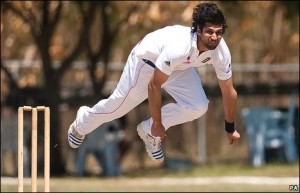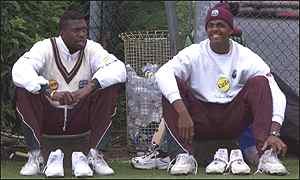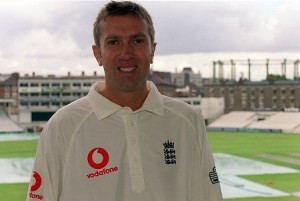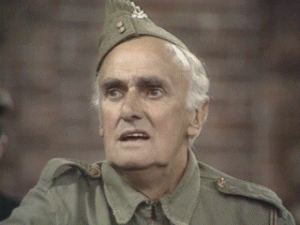
A gradual but inevitable descent into cricket-based loathing and bile.
Classic Series Review: West Indies vs. England 1994
England tours of the West Indies are often very memorable, with only the Steve Harmison-inspired 2004 series victory being unforgettable for the fact that England won. Indeed, their last tour, some short six years ago, was a shambles from start to finish. But if we were to review THAT series, we could be accused of being one-trick ponies. After all, there are only so many times we can post pictures of Amjad Khan doing his thing.
Historically, the West Indies dominated England for years. By 1994, the gulf between them was no longer Gulf-of-Mexico sized, but the West Indies still had not lost a series since 1980. However the gap was narrowing: gone were the years of consecutive blackwashes, fourth innings chases of 344/1 from 66.1 overs and Michael Holding embarrassing Geoffrey Boycott. In the 1989/90 series England had won a match(!), whilst at home in the summer of 1991 they had drawn the series in impressive style. Since then however, England had been on a downward spiral, including being humiliated in India and trounced in the 1993 Ashes – during which Graham Gooch was replaced as captain by relatively young Michael Atherton. As ever, they seemed in transition.
The Maroon Caps, as no-one ever calls them, were also a changed side. Four of their core players from the 1980s had moved on, in the irreplaceable shape of Viv Richards, Gordon Greenidge, Jeffrey Dujon and Malcolm Marshall. Yet their side still contained Desmond Haynes (ranked no. 2 batsman in the world) and Richie Richardson; the bowling attack was led by Courtney and Curtly (their surnames need not be mentioned) and supported by any number of decent fast bowlers.
At least the Windies had experience at their heart of the team though. England’s squad of 17 featured no player older than 30 and only six players with 20 or more Test caps. Such was the inevitable outcome of a longstanding selection policy of picking players (especially seamers) only to jettison them after a few games. Controversially, for the first time since the 1970s the squad did not feature one of the highly-experienced (i.e. ageing) quartet of Allan Lamb, Mike Gatting, David Gower or Graham Gooch. The latter had made himself unavailable – even though he was still ranked no. 1 in the world – whilst the selectors, perhaps understandably, wanted to move on from the previous generation.
Back in the 1990s, most of England’s overseas tours seemed to include at least one embarrassing defeat to a state side in an upcountry location. Somehow this tour was different, with England winning two and drawing three of their warm-up games, with several batsmen making important contributions and Chris Lewis getting injured with sunstroke after shaving his head. Even the ODIs weren’t a complete shambles: West Indies won 3-2 but thanks mostly to the batting; Ambrose, Walsh and Winston Benjamin averaged 72, 150 and 114 respectively. The other noteworthy point about the start of the tour was that the opening Test was weirdly scheduled between the first two ODIs, with the one-day series then being completed before the second Test. How bizarre.
So then…to the Tests.
First Test, Jamacia
Things might have looked rosy for England when Alec Stewart and Atherton were 121/0 on the first day, but Kenny Benjamin – hitherto unsung compared with Ambrose, Walsh and the injured Ian Bishop – removed both. Cue an England collapse resulting in them being dismissed for 234, with Benjamin finishing with devilishly good figures of 6/66. Devon Malcolm and Andy Caddick started well, dismissing Haynes, Richardson and Phil Simmons quickly, but the young middle order soon turned things around. Brian Lara continued his rapid ascent in Test cricket with 83, Keith Arthurton top-scored with 126 and Jimmy Adams was undefeated for 95.
In England’s second knock, the sole man to resist the onslaught for more than two hours was surprisingly Graeme Hick, whose previous exploits against the West Indians resembled the Iraqi resistance during the first Gulf War. Dictionary definition of a no. 11 Malcolm also deserves a mention for a personal best of 18 in the face of some extremely hostile bowling from Walsh. But England were only able to set their hosts a target of 95, which was chased down for the loss of just two wickets.Business very much as usual.
Second Test, Guyana
After the interlude of the ODIs, the second match took place on the South American continent. West Indies surprisingly replaced Simmons with local boy Shivnarine Chanderpaul; England opted for a specialist spinner, one Ian Salisbury, to replace the injured Malcolm. Mark Ramprakash replaced Matthew Maynard and the seamers were shuffled, with Angus Fraser replacing Caddick.
After Walsh struck twice early on, Atherton (144) and Robin Smith (84) set England up nicely with a large partnership, but any side with Salisbury batting at no. 7 are destined to collapse. This time it was Ambrose who led the way with four wickets. The West Indies innings lasted a mammoth 153 overs, 35 of which were shared by Hick and Rampraskash. Adams recorded a maiden Test century, Chanderpaul scored a half-century and Lara blasted 167. Their total of 556ao was always a winning position, but at least in trying to save the match England lasted more than 80 overs, thanks to Stewart’s 79 and some solid hanging around by Lewis and Salisbury (really!). Ambrose’s eight wickets in the match were beaten by Lara’s century to the man of the match award.
Third Test, Trinidad
It was here where the series really became memorable. England secured a 76-run lead on first innings, Graham Thorpe top-scoring with 86. West Indies struggled from the outset in their second stint, particularly thanks to an unsung legend in the field: as Wisden described it, Lara was dismissed “through a spectacular diving catch at mid-off by Salisbury.” With Caddick taking 6/65, and only Chanderpaul reaching 50, England had just 194 to score to win.
After a break for rain, England began their chase with 15 overs remaining on the fourth evening. They managed to score 40 runs before stumps. Sadly the not out batsmen overnight, Caddick and Lewis, weren’t nightwatchmen. Ambrose, supported by Walsh, had blown England away like chip papers in a hurricane. Atherton – first ball. Smith – second ball. Thorpe – out 28th ball for three. Salisbury, promoted back up the order to no. 7, presumably as payment for his catch, went third ball. It was a sorry night for England as they went to bed with just two wickets remaining. They might as well have stayed there: the tail hung around for 17 short minutes before Walsh wrapped things up. Ambrose had six in the innings, eleven in the match and England’s 46ao probably gave rise to some kind of rubbish GeoCities site about cricket.
3-0 down, two to play. Surely another blackwash was on the cards?
Fourth Test, Barbados
The home side had won their previous 12 Tests at the Kensington Oval. No visiting side had won a Test match here since the 1930s. West Indies won the toss and fielded. It seemed inevitable that the thousands of visiting England fans would suddenly have a few spare days on their itinerary.
The openers put on 171 for the first wicket until the captain was dismissed for 85. But Stewart persevered to reach 118. England did suffer another mini-collapse, losing their last five wickets for fewer than 50 runs (Ambrose with four of the wickets) to finish on 355ao, which looked a reasonable total, if not a winning one. But in response, the Windies rarely got going, due to defensive bowling from Phil Tufnell at one end (recalled for the hapless Salisbury) and impregnable lines of attack from Fraser at the other. In one mini-spell, Fraser took an Ambrose-like four wickets for one run from 17 balls, ripping out the middle order and Haynes in the process. Only a dogged, Chanderpaulesque innings from Chanderpaul (77 runs in 305 minutes), accompanied by some biffing from Ambrose and Kenny Benjamin steered the West Indies to 304. It is rumoured that upon taking his eighth wicket, even Fraser broke out into a vague smile.
Of course, this being a) the 1990s and b) England, things could still go horribly wrong. With Athers, Rampers and Smithers back in the dressing room early, it might have done. But Stewart batted and batted, compiling a historic 143 runs (the first Englishman to score twin hundreds against this opponent) with support from both Hick and Thorpe. Aided by 36 no balls and some last-minute bashing by Lewis, Atherton was eventually able to declare with a lead of 445 runs.
Disadvantaged by Haynes having to bat lower down the order (due to a finger injury) and makeshift opener Richardson retiring hurt, West Indies were never in the chase. Caddick, for the first time was a hero, taking five of the first seven wickets. Fraser, presumably dog tired after the first innings went wicketless, but Hick, Tufnell and Lewis shared the rest. All out for 237, this was arguably as humiliating for the home team as the defeat at Port-of-Spain had been for England. Atherton’s men went mad, the Barmy Army went barmy and no doubt England partied to the sound of Toni Di Bart.
Fifth Test, Antigua
And so to St John’s and its Recreation Ground. One of the flattest tracks since Mike Gatting stood on his son’s Scalextric. One of the boringest draws ever, but with the small matter of Lara making 375 and surpassing all Test innings that had come before. Famously, Lara almost didn’t make it, as his foot brushed the stumps and very nearly dislodged the bail as he pulled Lewis for 4. What is less well-remembered is that England managed to equal the West Indies total: 593/5 from 118 overs versus 593ao from 206. Smith scored 175, Atherton 135 and even Lewis 75*. Walsh went wicketless from 40 overs. But of course, the match is irrelevant, for it was all about the iconic moment when Lara hit that boundary and the pitch was invaded by hundreds of fans, including Sir Garfield Sobers, who strangely was not chased by stewards in hi-vis tabards, arrested and banned from all cricket grounds for 12 months.
It signalled the emergence of a new superstar, coinciding with a decline in the West Indies overall performance (it was a year later that Australia beat them in the Caribbean to signal the changeover as the undisputed best team in the world). For England, it was another pretty poor tour, offset partially by a remarkably dominant victory in Barbados. And they would continue to change their line-up with the regularity of The Fall: not finding a settled bowling attack for another six years and even recalling Gatting and Gooch for the Ashes of 1994/95.
So as series go, it wasn’t a complete classic, which we had to lie about in the title in order to trick you into reading this. But it continues to be remembered for a handful of classic performances, scorecards and moments. In particular, England being bowled out for 46 set us on the terrible path that leads us here today.






No Comments
Post a Comment